Harvard College
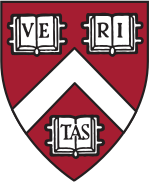 | |
| Type | Private nonprofit college |
|---|---|
| Established | 1636 |
| Dean | Rakesh Khurana |
| Students | 6,755[1] |
| Location | Cambridge , Massachusetts , United States |
| Campus | Urban |
| Website | college |
Harvard College is the undergraduate college of Harvard University, an Ivy League research university in Cambridge, Massachusetts. Founded in 1636, Harvard College is the original school of Harvard University, the oldest institution of higher learning in the United States[2] and among the most prestigious in the world.[3]
Part of the Faculty of Arts and Sciences, Harvard College is Harvard University's traditional undergraduate program, offering AB and SB degrees. It is highly selective, with fewer than five percent of applicants being offered admission in recent years.[4][5] Harvard College students participate in more than 450 extracurricular organizations[6] and nearly all live on campus—first-year students in or near Harvard Yard, and upperclass students in community-oriented "houses".
The college has produced many distinguished alumni, including high-ranking politicians, renowned scholars, and business leaders.
History[]

The school came into existence in 1636 by vote of the Great and General Court of the Massachusetts Bay Colony—though without a single building, instructor, or student. In 1638, the college became home for North America's first known printing press, carried by the ship John of London.[7][8] Three years later, the college was renamed in honor of deceased Charlestown minister John Harvard (1607–1638) who had bequeathed to the school his entire library and half of his monetary estate.
Harvard's first instructor was schoolmaster Nathaniel Eaton (1610–1674); in 1639, he also became its first instructor to be dismissed, for overstrict discipline.[9] The school's first students were graduated in 1642.
The Harvard Indian College was established, with the capacity for four or five Native Americans, and in 1665 Caleb Cheeshahteaumuck (c. 1643–1666) "from the Wampanoag … did graduate from Harvard, the first Indian to do so in the colonial period."[10]
The colleges of England's Oxford and Cambridge Universities are communities within the larger university, each an association of scholars sharing room and board. Harvard's founders may have envisioned it as the first in a series of sibling colleges on the English model which would eventually constitute a university—though no further colleges materialized in colonial times. The Indian College was active from 1640 to no later than 1693, but it was a minor addition not operated in federation with Harvard according to the English model. Harvard began granting higher degrees in the late eighteenth century, and it was increasingly styled Harvard University, even as Harvard College was increasingly thought of as the university's undergraduate division in particular.[citation needed]

Currently, Harvard College is responsible for undergraduate admissions, advising, housing, student life, and athletics—generally all undergraduate matters except instruction, which is the purview of the Harvard Faculty of Arts and Sciences. The body known as the President and Fellows of Harvard College retains its traditional name despite having governance of the entire University. Radcliffe College, established in 1879, originally paid Harvard faculty to repeat their lectures for women.[12] Since the 1970s, Harvard has been responsible for undergraduate matters for women, though women's Harvard diplomas were countersigned by the President of Radcliffe until a final merger in 1999.[13]
Admissions[]
| Admissions statistics | |
|---|---|
2021 entering class[14] | |
| Admit rate | 3.4% |
Admission is based on academic prowess, extracurricular activities, and personal qualities. For the undergraduate class of 2025, Harvard had 57,435 applications and accepted 1,968 (3.4% acceptance rate). For the undergraduate class of 2023, the middle 50% range of SAT scores of enrolled freshmen was 710–770 for reading and writing and 750–800 for math, while the middle 50% range of the ACT composite score was 33–35. The average high school grade point average (GPA) was 4.18.[1] The acceptance rate for transfer students has been approximately 1%.[15]
Harvard College ended its early admissions program in 2007, but for the class of 2016 and beyond, an early action program was reintroduced.[16] The freshman class that entered in the fall of 2017 was the first to be majority (50.8%) nonwhite.[17]
A federal lawsuit alleges that Harvard's admissions policies discriminate against Asian Americans, who tend to be overrepresented among students with high academic achievement.[18][19] A 2019 district court decision in the case (which has since been appealed) found no evidence of explicit racial bias but did not rule out a small amount of implicit bias.[20] Harvard has implemented more implicit bias training for its admissions staff in accordance with the court's recommendations.[21][22] In addition, Harvard's admissions preference for children of alumni, employees, and donors has been criticized as favoring white and wealthy candidates.[23][24][25]
The median family income of Harvard students is $168,800, with 53% of students coming from the top 10% highest-earning families and 20% from the bottom 60%.[26] As of 2019, Harvard College tuition was about $48,000 and total costs about $70,000. However, Harvard offers one of the most generous financial aid programs in the United States, with need-blind admission and 100% of financial need met for all students. Families with incomes below $65,000 pay nothing for their children to attend, while families earning up to $150,000 pay no more than 10% of their annual incomes. Financial aid is solely based on need; no merit or athletic scholarships are offered.[27]
Academics[]
The four-year, full-time undergraduate program has a liberal arts and sciences focus.[28][29] To graduate in the usual four years, undergraduates normally take four courses per semester.[30]
Midway through the second year, most undergraduates join one of fifty academic majors; many also declare a minor (secondary field). Joint majors (combining the requirements of two majors) and special majors (of the student's own design) are also possible.[29] Most majors lead to the Artium Baccalaureus (AB). Some award the Scientiae Baccalaureus (SB). There are also dual degree programs permitting students to earn both a Harvard AB and a Master of Music (MM) from either the New England Conservatory of Music or the Berklee College of Music over five years.[31] In most majors, an honors degree requires advanced coursework and/or a senior thesis.[32]
Harvard College students must take a course in each of four General Education categories (Aesthetics and Culture; Ethics and Civics; Histories, Societies, Individuals; Science and Technology in Society)[33] as well as a course in each of three academic divisions (Arts and Humanities; Social Sciences; Science and Engineering and Applied Science). They must also fulfill foreign language, expository writing, and quantitative reasoning with data requirements.[33] Exposure to a range of intellectual areas in parallel with pursuit of a chosen major in depth fulfills the injunction of former Harvard president Abbott Lawrence Lowell that liberal education should produce "men who know a little of everything and something well".[34]
Some introductory courses have large enrollments, but most courses are small: the median class size is 12 students.[35] Funding and faculty mentorship for research is available in all disciplines for undergraduates at all levels.[36]
Student life[]
House system[]

Nearly all undergraduates live on campus, for the first year in dormitories in or near Harvard Yard and later in the upperclass houses—administrative subdivisions of the college as well as living quarters, providing a sense of community in what might otherwise be a socially incohesive and administratively daunting university environment. Each house is presided over by two faculty deans, while its Allston Burr Resident Dean—usually a junior faculty member—supervises undergraduates' day-to-day academic and disciplinary well-being.
The faculty deans and resident dean are assisted by other members of the Senior Common Room—select graduate students (tutors), faculty, and university officials brought into voluntary association with each house. The faculty deans and resident dean reside in the house, as do resident tutors. Terms like tutor, Senior Common Room, and Junior Common Room reflect a debt to the residential college systems at Oxford and Cambridge from which Harvard's system took inspiration.[37]
The houses were created by President Lowell in the 1930s to combat what he saw as pernicious social stratification engendered by the private, off-campus living arrangements of many undergraduates at that time. Lowell's solution was to provide every man—Harvard was male-only at the time—with on-campus accommodations throughout his time at the college; Lowell also saw great benefits in other features of the house system, such as the relaxed discussions—academic or otherwise—which he hoped would take place among undergraduates and members of the Senior Common Room over meals in each house's dining hall.[38]
How students come to live in particular houses has changed greatly over time. Under the original "draft" system, masters (now faculty deans) negotiated privately over the assignment of students.[citation needed] From the 1960s to the mid-1990s, each student ranked the houses according to personal preference, with a lottery resolving the oversubscription of more popular houses. Today, groups of one to eight freshmen form a block which is then assigned, essentially at random, to an upperclass house.
A total of nine "River Houses" are located south of Harvard Yard, near the Charles River: Adams, Dunster, Eliot, Kirkland, Leverett, Lowell, Mather, Quincy, and Winthrop. Their construction was financed largely by a 1928 gift from Yale alumnus Edward Harkness, who, frustrated in his attempts to initiate a similar project at his alma mater, eventually offered $11 million to Harvard.[a][42] Two of the houses, Dunster and Lowell, were completed in 1930.[39]
Construction of the first houses began in 1929,[39] but the land on which they were built had been assembled decades before. After graduating from Harvard in 1895, Edward W. Forbes found himself inspired by the Oxford and Cambridge systems during two years of study in England; on returning to the United States he set out to acquire the land between Harvard Yard and the Charles River that was not already owned by Harvard or an associated entity. By 1918, that ambition had been largely fulfilled and the assembled land transferred to Harvard.[43][44]
The three "Quad Houses" enjoy a residential setting half a mile northwest of Harvard Yard. These were built by Radcliffe College and housed Radcliffe College students until the Harvard and Radcliffe residential systems merged in 1977.[45] They are Cabot, Currier, and Pforzheimer House. A thirteenth house, Dudley House, is nonresidential but fulfills, for some graduate students and the (very few) undergraduates living off campus, the administrative and social functions provided to on-campus residents by the other twelve houses. Harvard's residential houses are paired with Yale's residential colleges in .
Student government[]
The Harvard Undergraduate Council (UC) is the 51-member student government of Harvard College. The student body at large elects the UC's president and vice president, while the twelve upperclass houses and four freshman neighborhoods each sends three representatives. (The Dudley Cooperative sends one representative.) The UC operates several committees on issues pertaining to undergraduates and allocates resources to student organizations.
Athletics[]
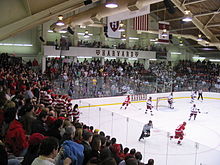
The Harvard Crimson fields 42 intercollegiate sports teams in the NCAA Division I Ivy League, more than any other NCAA Division I college in the country.[46] Every two years, the Harvard and Yale track and field teams come together to compete against a combined Oxford and Cambridge team in the oldest continuous international amateur competition in the world.[47] As with other Ivy League universities, Harvard does not offer athletic scholarships.[48]
Harvard's athletic rivalry with Yale is intense in every sport in which they meet, coming to a climax each fall in the annual football meeting, which dates back to 1875 and is usually called simply "The Game". While Harvard's football team is no longer one of the best as it was in football's early days, both Harvard and Yale have influenced the way the game is played. In 1903, Harvard Stadium introduced a new era into football with the first permanent reinforced concrete stadium of its kind in the country.[49][50]
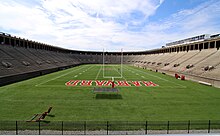
Even older than Harvard–Yale football rivalry, the Harvard–Yale Regatta is held each June on the Thames River in eastern Connecticut. The Harvard crew is typically considered to be one of the top teams in the country in rowing. Other sports in which Harvard teams are particularly strong are men's ice hockey, squash, and men's and women's fencing. Harvard's men's ice hockey team won the school's first NCAA Championship in any team sport in 1989, and Harvard also won the Intercollegiate Sailing Association National Championships in 2003. Harvard was the first Ivy League school to win an NCAA Championship in a women's sport when its women's lacrosse team won in 1990.[51]
The school color is crimson, which is also the name of Harvard's sports teams and the student newspaper, The Harvard Crimson. The color was unofficially adopted (in preference to magenta) by an 1875 vote of the student body, although the association with some form of red can be traced back to 1858, when Charles William Eliot, a young graduate student who would later become Harvard's 21st and longest-serving president (1869–1909), bought red bandanas for his crew so they could more easily be distinguished by spectators at a regatta.[52]
Fight songs[]
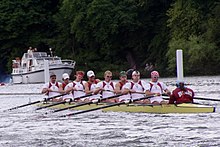
Harvard has several fight songs, the most played of which, especially at football, are "Ten Thousand Men of Harvard" and "Harvardiana". While "Fair Harvard" is actually the alma mater, "Ten Thousand Men" is better known outside the university. The Harvard University Band performs these fight songs and other cheers at football and hockey games. These were parodied by Harvard alumnus Tom Lehrer in his song "Fight Fiercely, Harvard", which he composed while an undergraduate.
Athletics history[]
By the late 19th century, critics of intercollegiate athletics, including Harvard president Charles William Eliot, believed that sports had become over-commercialized and took students away from their studies. They called for limitations on all sports. This opposition prompted Harvard's athletic committee to target "minor" sports—basketball and hockey—for reform in order to deflect attention from the major sports: football, baseball, track, and crew. The committee made it difficult for the basketball team to operate by denying financial assistance and limiting the number of overnight away games in which the team could participate.
Student organizations[]
Harvard has more than 450 undergraduate student organizations.[6][53] The acts as an umbrella service organization.
Notable alumni[]
This section may be too long to read and navigate comfortably. (June 2021) |
- Athletics
- Craig Adams
- Matt Birk
- Ryan Fitzpatrick
- Bobby Jones
- Jeremy Lin
- Dominic Moore
- Christopher Nowinski
- Paul Wylie
- Biology
- John Tyler Bonner
- Jared Diamond
- Eric Kandel
- George Minot
- Kiran Musunuru
- Gregg L. Semenza
- Harold M. Weintraub
- Business
- Steve Ballmer
- Lloyd Blankfein
- Jim Cramer
- Bill Gates (did not graduate)
- Kenneth C. Griffin
- Trip Hawkins
- William Randolph Hearst (did not graduate)
- Andy Jassy
- Sumner Redstone
- Sheryl Sandberg
- Eduardo Saverin
- Mark Zuckerberg (did not graduate)
- Chemistry
- Martin Chalfie
- Walter Gilbert
- Martin Karplus
- William Standish Knowles
- Charles Sanders Peirce
- Theodore William Richards
- William Howard Stein
- James B. Sumner
- Roger Y. Tsien
- Economics
- Ben Bernanke
- Martin Feldstein
- Jason Furman
- Michael Kremer
- Steven Levitt
- Merton Miller
- Christopher A. Sims
- Robert Solow
- James Tobin
- Journalism
- Ross Douthat
- Nicholas Kristof
- Anthony Lewis
- Walter Lippmann
- David E. Sanger
- Chris Wallace
- Kristen Welker
- Matthew Yglesias
- Law
- Harry Blackmun
- Merrick Garland
- Oliver Wendell Holmes Jr.
- Mark F. Pomerantz
- John Roberts
- David Souter
- Literature
- James Agee
- William S. Burroughs
- Michael Crichton
- E. E. Cummings
- John Dos Passos
- T. S. Eliot
- Amanda Gorman
- Norman Mailer
- Maxwell Perkins
- Erich Segal
- Wallace Stevens
- John Updike
- Mathematics
- Manjul Bhargava
- Buddy Fletcher
- David Mumford
- Daniel Quillen
- Performing arts
- Tatyana Ali
- Darren Aronofsky
- Paris Barclay
- Leonard Bernstein
- Andy Borowitz
- Amy Brenneman
- Carter Burwell
- Nestor Carbonell
- Rivers Cuomo
- Matt Damon (did not graduate)
- Fred Gwynne
- Rashida Jones
- Tommy Lee Jones
- Colin Jost
- Tom Lehrer
- Jack Lemmon
- Ryan Leslie
- John Lithgow
- Donal Logue
- Yo-Yo Ma
- Terrence Malick
- Tom Morello
- Dean Norris
- Conan O'Brien
- Natalie Portman
- Joshua Redman
- Meredith Salenger
- Elisabeth Shue
- Whit Stillman
- Mira Sorvino
- James Toback
- Philosophy
- Donald Davidson
- Daniel Dennett
- Ralph Waldo Emerson
- William James (did not graduate)
- Thomas Kuhn
- George Santayana
- Henry David Thoreau
- Cornel West
- Physics
- Philip W. Anderson
- Percy Williams Bridgman
- Roy J. Glauber
- Theodore Hall
- David Lee
- J. Robert Oppenheimer
- Saul Perlmutter
- Neil deGrasse Tyson
- Kenneth G. Wilson
- Politics
- John Adams
- John Quincy Adams
- Samuel Adams
- Charlie Baker
- Benazir Bhutto
- Antony Blinken
- Richard Blumenthal
- Pete Buttigieg
- Pedro Albizu Campos
- Tom Cotton
- Shaun Donovan
- Sir George Downing
- Al Franken
- Rahul Gandhi (did not graduate)
- Elbridge Gerry
- Al Gore
- John Hancock
- Ted Kennedy
- John F. Kennedy
- Robert F. Kennedy
- Henry Kissinger
- Phil Murphy
- Masako Owada
- Deval Patrick
- Gina Raimondo
- Tom Ridge
- Jay Rockefeller
- Franklin D. Roosevelt
- Theodore Roosevelt
- Ben Sasse
- Chuck Schumer
- Pat Toomey
- Religion
- Aga Khan IV
- Cotton Mather
- Increase Mather
- Theodore Parker
- Samuel Parris
- Miscellaneous
- Buckminster Fuller (did not graduate)
- Philip Johnson
- Ted Kaczynski
- Arthur M. Schlesinger Jr.
- Stephanie Wilson
- Notable alumni include:
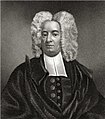
Minister, author, and pamphleteer Cotton Mather (AB, 1678)

US president John Adams[54] (AB, 1755)

Philosopher and poet Ralph Waldo Emerson (AB, 1821)

Naturalist, poet and philosopher Henry David Thoreau (AB, 1837)

US supreme court justice Oliver Wendell Holmes Jr. (AB, 1861)

Philosopher and mathematician Charles Sanders Peirce (AB, 1862)

US president and Nobel laureate in peace Theodore Roosevelt[57] (AB, 1880)

US president Franklin D. Roosevelt[58] (AB, 1903)

Author, political activist, and lecturer Helen Keller (AB, 1904, Radcliffe College)
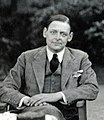
Poet and Nobel laureate in literature T. S. Eliot (AB, 1909)

Physicist J. Robert Oppenheimer (AB, 1925)

Composer Leonard Bernstein (AB, 1939)

US president John F. Kennedy[59] (AB, 1940)

US secretary of state and Nobel laureate in peace Henry Kissinger (AB, 1950)

US vice president and Nobel laureate in peace Al Gore (AB, 1969)

US senate majority leader Chuck Schumer (AB, 1971)

11th Prime Minister of Pakistan Benazir Bhutto (AB, 1973, Radcliffe College)

Philosopher, political activist, and social critic Cornel West (AB, 1973)

US attorney general Merrick Garland (AB, 1974)

Federal Reserve chair Ben Bernanke (AB, 1975)

US supreme court chief justice John Roberts (AB, 1976)

Microsoft founder Bill Gates (1977)[b]

US secretary of state Antony Blinken (AB, 1984)

Facebook cofounder Mark Zuckerberg (2006)[b]
Basketball player Jeremy Lin (AB, 2010)
Footnotes[]
References[]
- ^ Jump up to: a b "Common Data Set 2019-2020" (PDF). Office of Institutional Research. Harvard University. Retrieved 23 June 2020.
- ^ Rudolph, Frederick (1961). The American College and University. University of Georgia Press. p. 3. ISBN 0-8203-1285-1.
- ^
- Keller, Morton; Keller, Phyllis (2001). Making Harvard Modern: The Rise of America's University. Oxford University Press. pp. 463–481. ISBN 0-19-514457-0.
Harvard's professional schools... won world prestige of a sort rarely seen among social institutions. [...] Harvard's age, wealth, quality, and prestige may well shield it from any conceivable vicissitudes.
- Spaulding, Christina (1989). "Sexual Shakedown". In Trumpbour, John (ed.). How Harvard Rules: Reason in the Service of Empire. South End Press. pp. 326–336. ISBN 0-89608-284-9.
... [Harvard's] tremendous institutional power and prestige [...] Within the nation's (arguably) most prestigious institution of higher learning ...
- David Altaner (March 9, 2011). "Harvard, MIT Ranked Most Prestigious Universities, Study Reports". Bloomberg. Retrieved March 1, 2012.
- Collier's Encyclopedia. Macmillan Educational Co. 1986.
Harvard University, one of the world's most prestigious institutions of higher learning, was founded in Massachusetts in 1636.
- Newport, Frank. "Harvard Number One University in Eyes of Public Stanford and Yale in second place". Gallup.
- Leonhardt, David (September 17, 2006). "Ending Early Admissions: Guess Who Wins?". The New York Times. ISSN 0362-4331. Retrieved March 27, 2020.
The most prestigious college in the world, of course, is Harvard, and the gap between it and every other university is often underestimated.
- Hoerr, John. We Can't Eat Prestige: The Women Who Organized Harvard. Temple University Press. p. 3.
- Wong, Alia (September 11, 2018). "At Private Colleges, Students Pay for Prestige". The Atlantic.
Americans tend to think of colleges as falling somewhere on a vast hierarchy based largely on their status and brand recognition. At the top are the Harvards and the Stanfords, with their celebrated faculty, groundbreaking research, and perfectly manicured quads.
- Keller, Morton; Keller, Phyllis (2001). Making Harvard Modern: The Rise of America's University. Oxford University Press. pp. 463–481. ISBN 0-19-514457-0.
- ^ "Record-Low 4.59 Percent of Applicants Accepted to Harvard Class of 2022". The Harvard Crimson. 29 March 2018. Retrieved 16 September 2019.
- ^ "Record-Low 4.5 Percent of Harvard College Applicants Accepted to Class of 2023". The Harvard Crimson. 29 March 2019. Retrieved 16 September 2019.
- ^ Jump up to: a b "Student Activities". Retrieved 7 December 2019.
- ^ "The instrument behind New England's first literary flowering". Harvard University. Retrieved 2014-01-18.
- ^ "Rowley and Ezekiel Rogers, The First North American Printing Press" (PDF). Maritime Historical Studies Centre, University of Hull. Retrieved 2014-01-18.
- ^ Samuel Eliot Morison, Three Centuries of Harvard, 1636–1936 (1986)
- ^ Monaghan, E. J., 2005, p. 55, 59
- ^ Harvard College. "A Brief History of Harvard College". Harvard College. Retrieved 2011-07-25.
- ^ Schwager, Sally (2004). "Taking up the Challenge: The Origins of Radcliffe". In Laurel Thatcher Ulrich (ed.). Yards and Gates: Gender in Harvard and Radcliffe History. New York: Palgrave Macmillan. pp. 87–115. ISBN 1403960984.
- ^ Radcliffe Enters Historic Merger With Harvard. The Harvard Crimson (Report). Retrieved May 6, 2016.
- ^ "Harvard College accepts 1,968 to Class of 2025". Harvard Gazette. Harvard University. 2021-04-06. Retrieved 30 June 2021.
- ^ Menz, Petey. "The Real 1%: Harvard Admits 15 Transfer Students". The Harvard Crimson. Retrieved 14 June 2021.
- ^ Finder, Alan; Arenson, Karen W. (September 12, 2006). "Harvard Ends Early Admission". The New York Times.
- ^ Fernandes, Deirdre (August 3, 2017). "The majority of Harvard's incoming class is nonwhite". The Boston Globe. Retrieved August 4, 2017.
- ^ "Harvard's Ongoing Anti-Asian-American Micro-Aggression". National Review. 2018-06-19. Retrieved 2018-07-17.
- ^ "A lawsuit reveals how peculiar Harvard's definition of merit is". The Economist. Retrieved 2018-07-17.
- ^ "Harvard Won a Key Affirmative Action Battle. But the War's Not Over". The New York Times. October 2, 2019. Retrieved December 14, 2019.
- ^ Local Reaction To The Ruling In The Harvard Admission's Case
- ^ "In Wake of Admissions Lawsuit Decision, Khurana Agrees Harvard Must Become Aware of Biases". The Crimson. 23 October 2019. Retrieved 29 December 2019.
- ^ Golden, Daniel (January 15, 2003). "Admissions Preferences Given to Alumni Children Draws Fire". The Wall Street Journal.
- ^ Golden, Daniel (2006). The Price of Admission: How America's Ruling Class Buys Its Way into Elite Colleges—and Who Gets Left Outside the Gates. ISBN 1-4000-9796-7.
- ^ Todd, Sarah. "A new statistic reveals the startling privilege of white kids admitted to Harvard". Quartz. Retrieved 19 June 2020.
- ^ Aisch, Gregor; Buchanan, Larry; Cox, Amanda; Quealy, Kevin (18 January 2017). "Economic diversity and student outcomes at Harvard". The New York Times. Retrieved 9 August 2020.
- ^ "How Aid Works". Retrieved December 8, 2019.
- ^ "Carnegie Classifications – Harvard University". The Carnegie Foundation for the Advancement of Teaching. Retrieved August 28, 2010.
- ^ Jump up to: a b "Liberal Arts & Sciences". Harvard College. Retrieved December 16, 2019.
- ^ "The Bachelor of Arts and Bachelor of Science Degrees". Harvard College. Retrieved December 8, 2019.
- ^ "Dual Degree Music Programs". Harvard College. Retrieved December 16, 2019.
- ^ "Academic Information: The Concentration Requirement". Handbook for Students. Harvard College. Archived from the original on December 5, 2010. Retrieved August 28, 2010.
- ^ Jump up to: a b "Requirements". Retrieved November 22, 2019.
- ^ Lewis, Harry R. (2007). Excellence Without a Soul: Does Liberal Education Have a Future?. PublicAffairs. p. 48. ISBN 9781586485375.
- ^ "How large are classes?". Harvard College. Retrieved December 16, 2019.
- ^ "Research". Harvard College. Retrieved December 16, 2019.
- ^ Harvard College Office of Residential Life (2008). "History of the House System". Retrieved 2008-04-20.[permanent dead link]
- ^ Morison, Samuel Eliot (1936). Three Centuries of Harvard: 1636–1936. pp. 476–478.
- ^ Jump up to: a b c Bethell, John (1998). Harvard Observed: An Illustrated History of the University in the Twentieth Century. Cambridge: Harvard University Press. pp. 102–103. ISBN 9780674377332.
- ^ "Gifts – 1928–1929" (Press release). Harvard University News Office. June 20, 1929. HU 37.5, Harvard University Archives, Cambridge, Massachusetts "This figure [of gifts and legacies received during the year] includes $5,444,000 received from E. S. Harkness to defray the expenses of constructing the first Harvard houses."
- ^ John B. Fox Jr. (2007). The Faculty of Arts and Sciences at Harvard University, 1686–1933. President and Fellows of Harvard College. p. 142.
- ^ "Harkness and History". Harvard Magazine. November 2013. Retrieved 11 November 2015.
- ^ Lowe, Charles U. "The Forbes Story of the Harvard Riverside Associates: How Harvard Acquired the Land on which Lowell House was Built," February 20, 2002.lowell.harvard.edu Archived 2010-04-09 at the Wayback Machine
- ^ Sacks, Benjamin J. "Harvard's 'Constructed Utopia' and the Culture of Deception: the Expansion toward the Charles River, 1902–1932," The New England Quarterly 84.2 (June 2011): 286–317.[1]
- ^ Sofen, Adam A. "Radcliffe Enters Historic Merger With Harvard, April 21, 1999.[2]
- ^ "Harvard : Women's Rugby Becomes 42nd Varsity Sport at Harvard University". Gocrimson.com. August 9, 2012. Retrieved July 5, 2013.
- ^ "Yale and Harvard Defeat Oxford/Cambridge Team". Yale University Athletics. Archived from the original on October 13, 2011. Retrieved September 13, 2011.
- ^ "The Harvard Guide: Financial Aid at Harvard". Harvard University. September 2, 2006. Archived from the original on September 2, 2006. Retrieved August 29, 2010.
- ^ "History of American Football". Newsdial.com. Retrieved August 29, 2010.
- ^ Nelson, David M., Anatomy of a Game: Football, the Rules, and the Men Who Made the Game, 1994, pp. 127–128
- ^ "Teammates for Life". Harvard Magazine. June 5, 2015. Retrieved December 15, 2019.
- ^ https://www.thecrimson.com/article/2002/4/11/harvard-explained-why-is-crimson-harvards/
- ^ "List of Student Organizations". The President and Fellows of Harvard College. Harvard College. Retrieved 13 January 2016.
- ^ Barzilay, Karen N. "The Education of John Adams". Massachusetts Historical Society. Retrieved 20 September 2020.
- ^ "John Quincy Adams". The White House. Retrieved 21 September 2020.
- ^ Hogan, Margaret A. "John Quincy Adams: Life Before the Presidency". Miller Center. Retrieved 21 September 2020.
- ^ "Theodore Roosevelt - Biographical". Nobel Foundation. Retrieved 21 September 2020.
- ^ Leuchtenburg, William E. "Franklin D. Roosevelt: Life Before the Presidency". Miller Center. Retrieved 21 September 2020.
- ^ J. Selverstone, Marc. "John F. Kennedy: Life Before the Presidency". Miller Center. Retrieved 21 September 2020.
Further reading[]
- King, M. (1884). Harvard and Its Surroundings. Cambridge: Moses King.
- Monaghan, E. J. (2005). Learning to Read and Write in Colonial America. Boston: UMass Press.
External links[]
| Wikimedia Commons has media related to Harvard University. |
| Wikisource has the text of the Encyclopædia Britannica (9th ed.) article Harvard College. |
- 1636 establishments in Massachusetts
- Educational institutions established in the 1630s
- Harvard Square
- Harvard University
- Harvard Faculty of Arts and Sciences



























